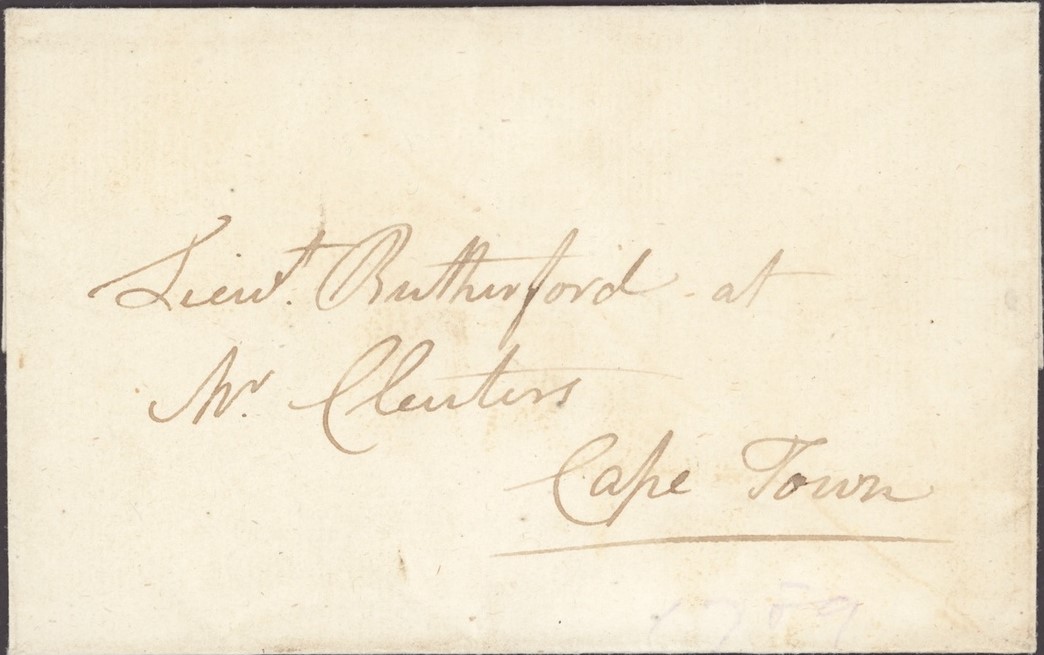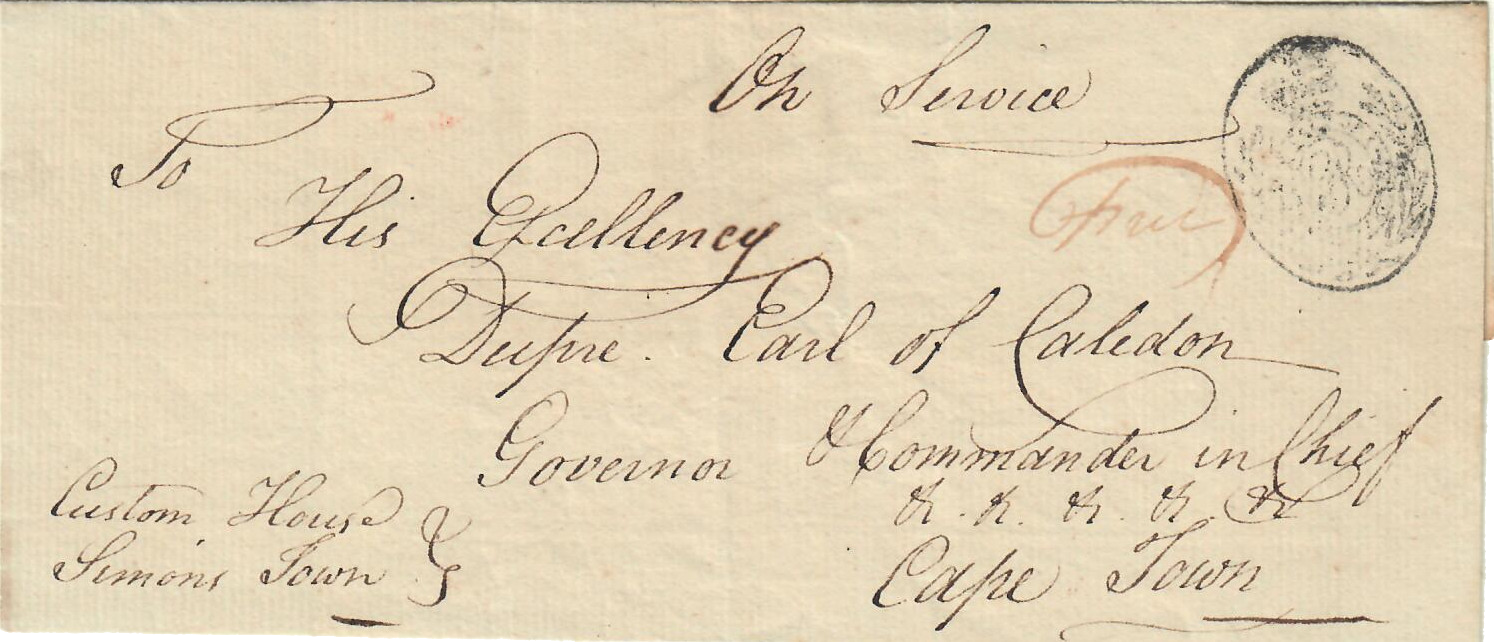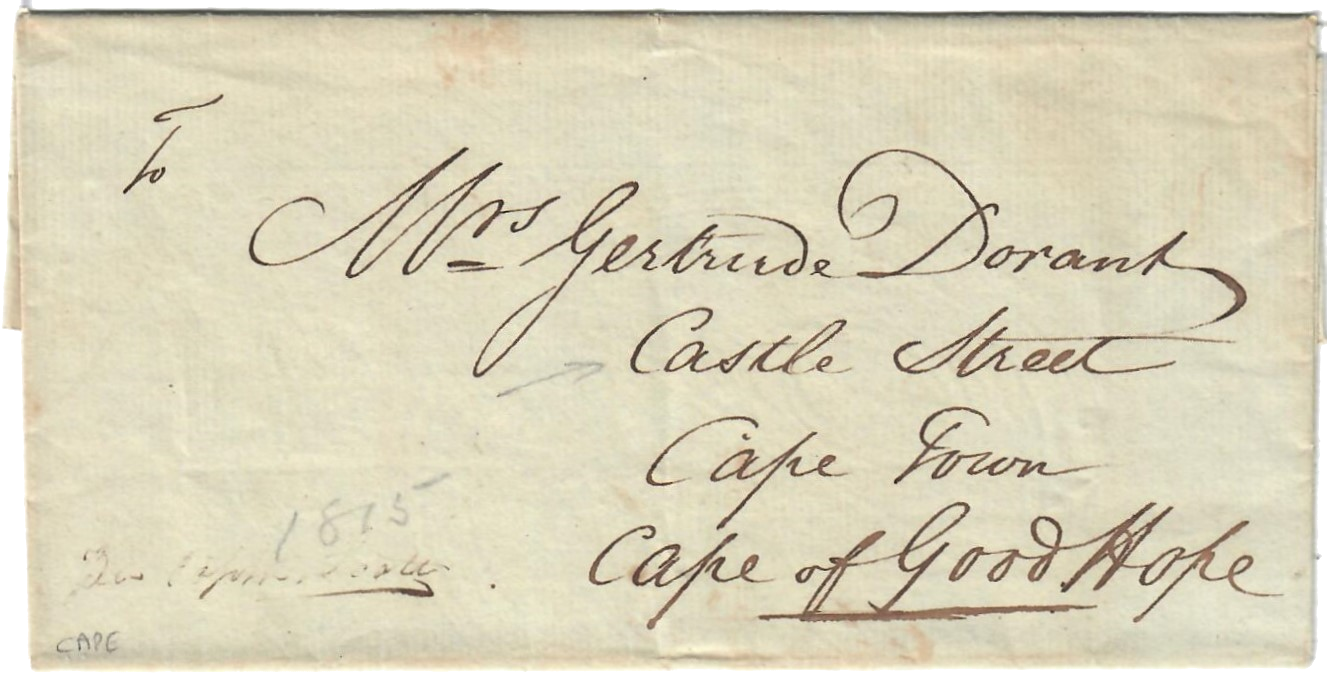Cape of Good Hope: An English Officer at Groot Constantia?
Quote from yannisl on May 26, 2021, 6:31 pmThe cover (1789) below and to be honest not a very attractive one is addressed to Lieut. Rutherford at Mr Cleuters; written on the inside of the wrapper. The gun powder and shot are in your chest. Local letters during this period are very uncommon and those in English more so, but the interesting part is the "at Mr Cleuters".
I think the name Cleuters could be a mispelling to that of Mr. Hendrik Cloete.
Teal in discussing some rogue British elements during the First British Occupation mentions that ... for sixteen years previously i.e., from 1789 (as he was referring to 1795), the property of Mr. Hendrik Cloete (Great Constantia) who was noted for his hospitality to all nations was broken into by a party of marines and blue-jackets who destroyed a great deal of the furniture, broke open the cellar, and knocked in the heads of a number of kegs of wine. Their propensity to do mischief was only checked by the wine taking effect on them.
What you think? Cleuter == Cloete?
The cover (1789) below and to be honest not a very attractive one is addressed to Lieut. Rutherford at Mr Cleuters; written on the inside of the wrapper. The gun powder and shot are in your chest. Local letters during this period are very uncommon and those in English more so, but the interesting part is the "at Mr Cleuters".
I think the name Cleuters could be a mispelling to that of Mr. Hendrik Cloete.
Teal in discussing some rogue British elements during the First British Occupation mentions that ... for sixteen years previously i.e., from 1789 (as he was referring to 1795), the property of Mr. Hendrik Cloete (Great Constantia) who was noted for his hospitality to all nations was broken into by a party of marines and blue-jackets who destroyed a great deal of the furniture, broke open the cellar, and knocked in the heads of a number of kegs of wine. Their propensity to do mischief was only checked by the wine taking effect on them.
What you think? Cleuter == Cloete?
Uploaded files:
Quote from Steve on May 27, 2021, 9:25 amActually, a lovely cover, particularly attractive because of the period. Lady Anne Barnard, et al.
Yes, 'Cleuters' is probably an anglicisation of 'Cloete'. At the time of their First Occupation of the Cape, 1795, the British had no experience of the Cape Dutch and their names. Their immediate solution was to spell names phonetically.
In those days Groot Constantia was some distance out of town and not a part of the settlement under 'ou Tafelberg'. It is a bit of a long shot to associate this with the famous Hendrik Cloete but given what you say about the man's hospitality - and his likely need to ingratiate himself with the new imperial order at the Cape - yours is not a far-fetched propsal. For reasons of historical romance, I want it to be Mr Cloete of Groot Constantia.
There were other Cloetes in de Kaap / Cape Town. Many of the Cape Peninsula Cape Dutch and some in the wider Western Cape became anglicized Afrikaners and found favour and success supporting the imperial status quo. This required a fair bit of sucking up, elocution lessons, the right school and some natural talent. See: https://en.wikipedia.org/wiki/Abraham_Josias_Clo%C3%ABt%C3%A9
What is also interesting for me as a Capetonian, (actually, I am more of a Capey), is the use of 'Cape Town' as a place name. The Dutch being Dutch had no reason to call it 'Cape Town', to them it was 'de Kaap'. It took quite some time for the word 'Kaapstad' to appear, maybe as long as 100 years or so. The British navy called the place 'Table Bay' but your cover shows early use of 'Cape Town' which I note is spelled as two words. It would be fun to do some research into the emergence of Kaapstad and Cape Town as a place name. My guess is that the first instances of their use are quite close in the chronology of the Cape's development.
(As an aside, I recently searched on a well-known Paquebot Mark database for Cape Town and could not find a single reference to it because its authors had in their wisdom spelled Cape Town as 'Capetown', one word, which not only looks wrong but is wrong!)
A very nice cover and a very interesting post, one redolent with early Cape Town history. Thanks.
Actually, a lovely cover, particularly attractive because of the period. Lady Anne Barnard, et al.
Yes, 'Cleuters' is probably an anglicisation of 'Cloete'. At the time of their First Occupation of the Cape, 1795, the British had no experience of the Cape Dutch and their names. Their immediate solution was to spell names phonetically.
In those days Groot Constantia was some distance out of town and not a part of the settlement under 'ou Tafelberg'. It is a bit of a long shot to associate this with the famous Hendrik Cloete but given what you say about the man's hospitality - and his likely need to ingratiate himself with the new imperial order at the Cape - yours is not a far-fetched propsal. For reasons of historical romance, I want it to be Mr Cloete of Groot Constantia.
There were other Cloetes in de Kaap / Cape Town. Many of the Cape Peninsula Cape Dutch and some in the wider Western Cape became anglicized Afrikaners and found favour and success supporting the imperial status quo. This required a fair bit of sucking up, elocution lessons, the right school and some natural talent. See: https://en.wikipedia.org/wiki/Abraham_Josias_Clo%C3%ABt%C3%A9
What is also interesting for me as a Capetonian, (actually, I am more of a Capey), is the use of 'Cape Town' as a place name. The Dutch being Dutch had no reason to call it 'Cape Town', to them it was 'de Kaap'. It took quite some time for the word 'Kaapstad' to appear, maybe as long as 100 years or so. The British navy called the place 'Table Bay' but your cover shows early use of 'Cape Town' which I note is spelled as two words. It would be fun to do some research into the emergence of Kaapstad and Cape Town as a place name. My guess is that the first instances of their use are quite close in the chronology of the Cape's development.
(As an aside, I recently searched on a well-known Paquebot Mark database for Cape Town and could not find a single reference to it because its authors had in their wisdom spelled Cape Town as 'Capetown', one word, which not only looks wrong but is wrong!)
A very nice cover and a very interesting post, one redolent with early Cape Town history. Thanks.
Quote from yannisl on May 27, 2021, 4:41 pmI agree with your statement that Cape Town, should be spelled with two words. Thanks for the link.
It is also true that the British Navy called it 'Table Bay', but on covers it might be addressed to a ship. By the second occupation it is easier to find covers with Cape Town, and some of them with the street name at the address panel. Certainly the bureaucracy called it that from the earlier days.
I agree with your statement that Cape Town, should be spelled with two words. Thanks for the link.
It is also true that the British Navy called it 'Table Bay', but on covers it might be addressed to a ship. By the second occupation it is easier to find covers with Cape Town, and some of them with the street name at the address panel. Certainly the bureaucracy called it that from the earlier days.
Uploaded files:
Quote from Steve on May 28, 2021, 6:51 amI have just had a quick look at my earliest Cape covers. I do not have a lot. Under the Dutch it seems Cape Town or Kaapstad was simply known as 'Cabo de Goede Hoop' or 'de Kaap'. I have no Dutch covers referencing 'Kaapstad'. At the same time there are references to outlying places like Paarl and Swellendam. After the British arrived in 1795 and again in 1806 they began to refer to 'Cape Town'. I only have British covers from the Second Occupation period that reference 'Cape Town'. Your cover from the First Occupation is presumably a very early example of 'Cape Town'. I wonder if the Dutch, later the Afrikaans 'Kaapstad', did not derive directly as a translation of the English 'Cape Town'? It seems to me that postal history is eminently suited to providing an answer to this question.
Again, you have posted another lovely, historic cover, this time an early Second Occupation one. It is from Simonstown to Cape Town where it was received with South Africa's first postmark, unless anyone wants to debate the use of the VOC handstamp in de Kaap. It is curious that after the British arrived at the Cape, we almost immediately find this Oval Medallion handstamp on letters, whereas the famed VOC handstamp is invisible, examples of its use at de Kaap being as rare as hen's teeth. The difference, of course, is that the British used the Oval Medallion handstamp on Cape domestic mail of which we have many surviving examples, like the one you provide. The VOC did not offer a domestic postal system and apparently used their handstamp, if it was used at all, only on overseas mail leaving de Kaap. For various reasons, such mail is not easily identifiable as originating in the Cape, perhaps impossibly so. However, such is the enthusiasm to have an example of a VOC handstamp in a Cape collection, collectors buy incoming Dutch covers stamped with the VOC handstamp in Holland or Batavia, thereby perpetuating the thin and somewhat forlorn hope of use of the VOC handstamp at de Kaap.
I have just had a quick look at my earliest Cape covers. I do not have a lot. Under the Dutch it seems Cape Town or Kaapstad was simply known as 'Cabo de Goede Hoop' or 'de Kaap'. I have no Dutch covers referencing 'Kaapstad'. At the same time there are references to outlying places like Paarl and Swellendam. After the British arrived in 1795 and again in 1806 they began to refer to 'Cape Town'. I only have British covers from the Second Occupation period that reference 'Cape Town'. Your cover from the First Occupation is presumably a very early example of 'Cape Town'. I wonder if the Dutch, later the Afrikaans 'Kaapstad', did not derive directly as a translation of the English 'Cape Town'? It seems to me that postal history is eminently suited to providing an answer to this question.
Again, you have posted another lovely, historic cover, this time an early Second Occupation one. It is from Simonstown to Cape Town where it was received with South Africa's first postmark, unless anyone wants to debate the use of the VOC handstamp in de Kaap. It is curious that after the British arrived at the Cape, we almost immediately find this Oval Medallion handstamp on letters, whereas the famed VOC handstamp is invisible, examples of its use at de Kaap being as rare as hen's teeth. The difference, of course, is that the British used the Oval Medallion handstamp on Cape domestic mail of which we have many surviving examples, like the one you provide. The VOC did not offer a domestic postal system and apparently used their handstamp, if it was used at all, only on overseas mail leaving de Kaap. For various reasons, such mail is not easily identifiable as originating in the Cape, perhaps impossibly so. However, such is the enthusiasm to have an example of a VOC handstamp in a Cape collection, collectors buy incoming Dutch covers stamped with the VOC handstamp in Holland or Batavia, thereby perpetuating the thin and somewhat forlorn hope of use of the VOC handstamp at de Kaap.
Quote from yannisl on May 28, 2021, 10:29 amYou right regarding the use of English. As soon as the British took over they tried to anglicize the bureaucracy. I have see only one early cover with the address having a) a street name b) Cape Town and c) Cape of Good Hope all in English.
The item is an 1815 large format outer letter sheet addressed in English to Mrs Gertrude Dorant, Castle Street, Cape Town. There are no postal markings or wax seals. Gertrude was married to a Henrik Dorant that owed a Billiard House on 4 Zieke Street and they must have been staying in rented accommodation in Castle Street. Henrik Dorant must have been a recent immigrant, as he appears in the records only from 1812-1814. She had an only daughter Mary Ann Louisa Dorant born on March 20, 1810.
In 1823 Gertrude Helena Coenradie-Dorant passed away. Her estate was wound by the Orphan Chamber. Her meager possessions were listed by the executors (MOOC 8/44.2a). Perhaps the only valuable possesion was her slave girl. Gertrude had two children who became the posssession of the Orphan Chamber who were to manage the Estate as her only daughter was a minor of 13 years of age. No.4 Zieke street does not appear in the Gazettes until 1817 again, now rented by a Gender, Garmett, Cabinetmaker.
You right regarding the use of English. As soon as the British took over they tried to anglicize the bureaucracy. I have see only one early cover with the address having a) a street name b) Cape Town and c) Cape of Good Hope all in English.
The item is an 1815 large format outer letter sheet addressed in English to Mrs Gertrude Dorant, Castle Street, Cape Town. There are no postal markings or wax seals. Gertrude was married to a Henrik Dorant that owed a Billiard House on 4 Zieke Street and they must have been staying in rented accommodation in Castle Street. Henrik Dorant must have been a recent immigrant, as he appears in the records only from 1812-1814. She had an only daughter Mary Ann Louisa Dorant born on March 20, 1810.
In 1823 Gertrude Helena Coenradie-Dorant passed away. Her estate was wound by the Orphan Chamber. Her meager possessions were listed by the executors (MOOC 8/44.2a). Perhaps the only valuable possesion was her slave girl. Gertrude had two children who became the posssession of the Orphan Chamber who were to manage the Estate as her only daughter was a minor of 13 years of age. No.4 Zieke street does not appear in the Gazettes until 1817 again, now rented by a Gender, Garmett, Cabinetmaker.
Uploaded files:



